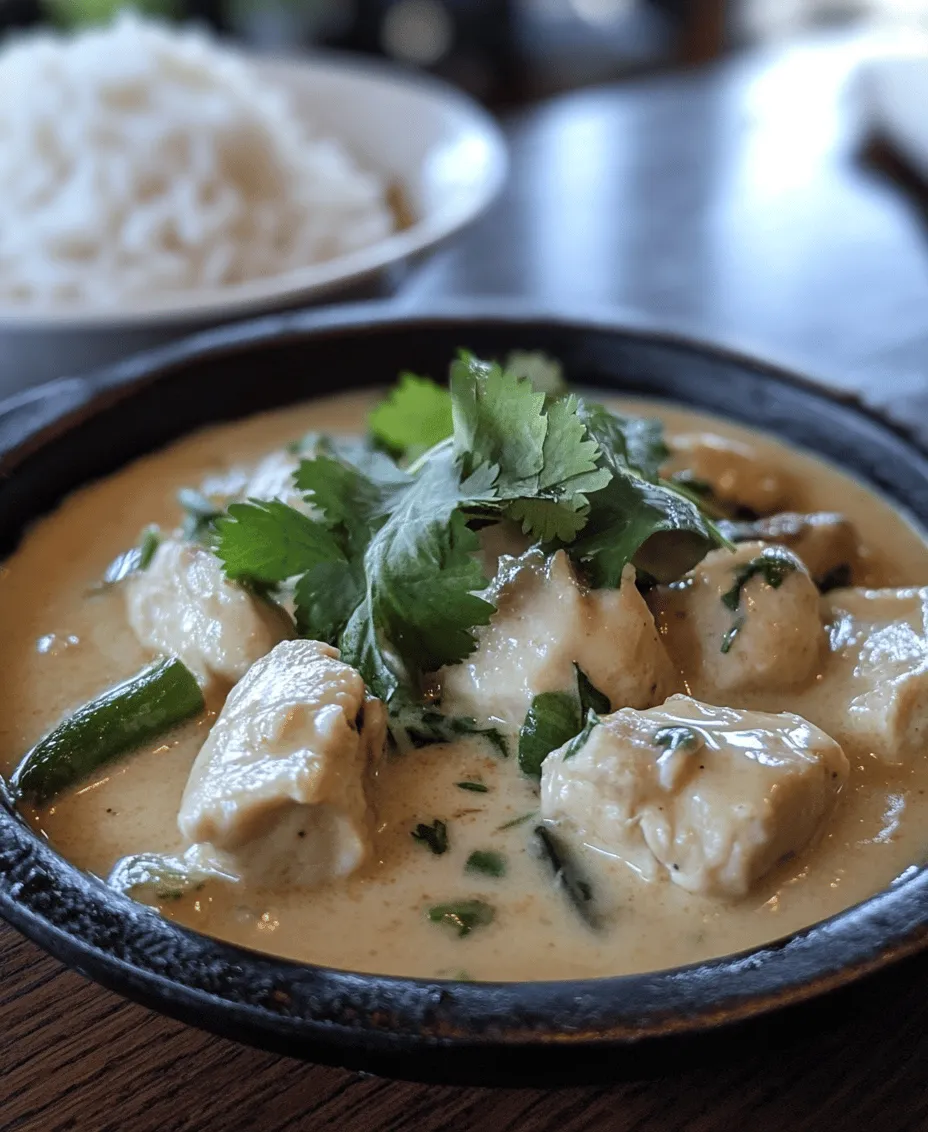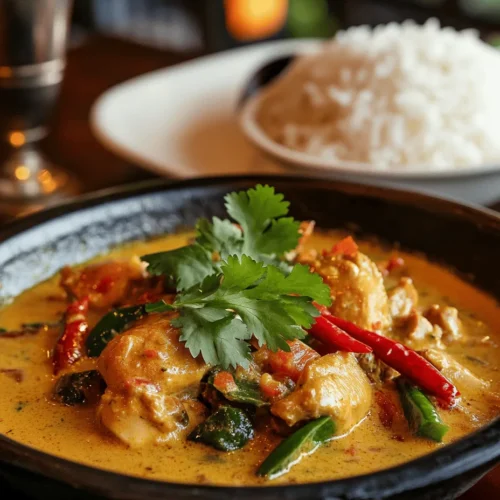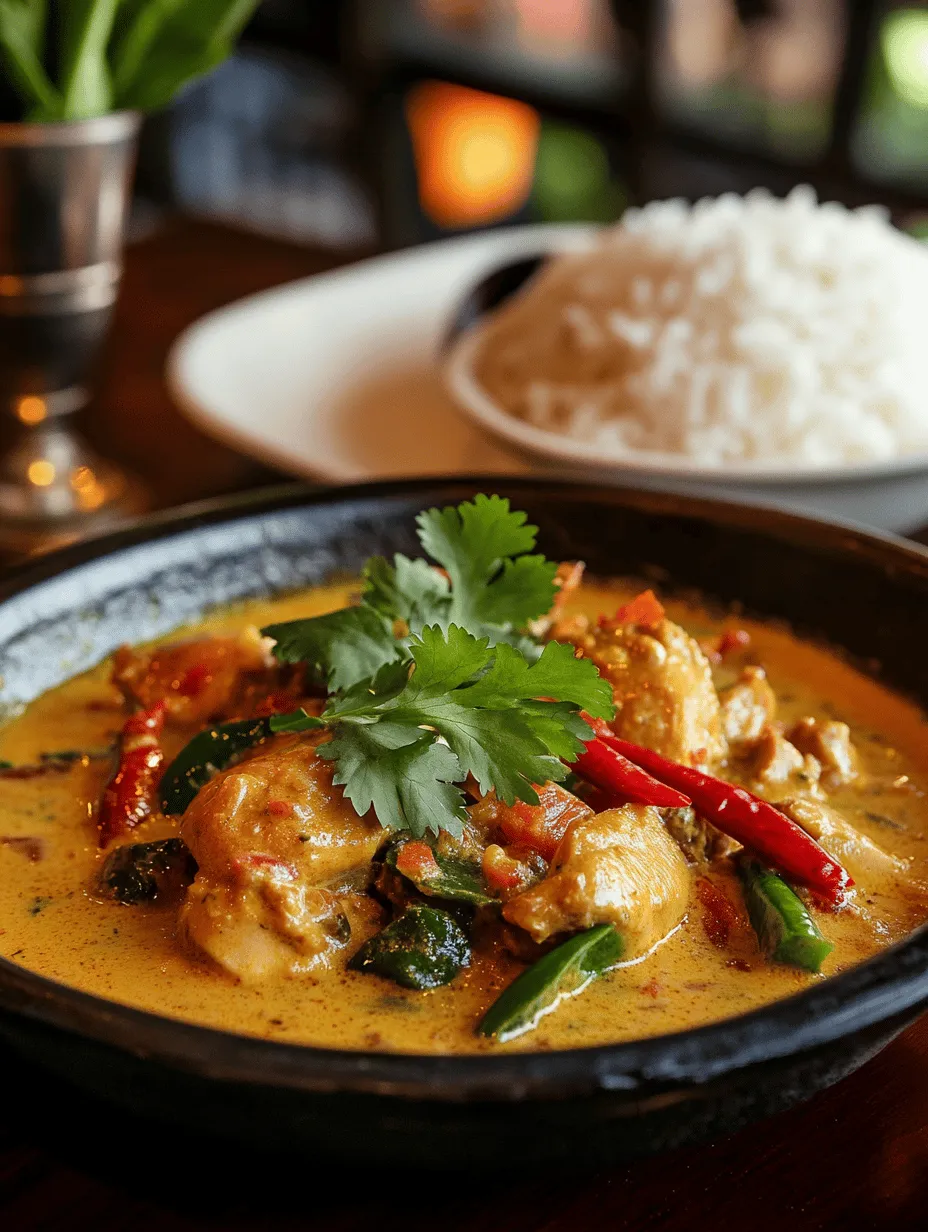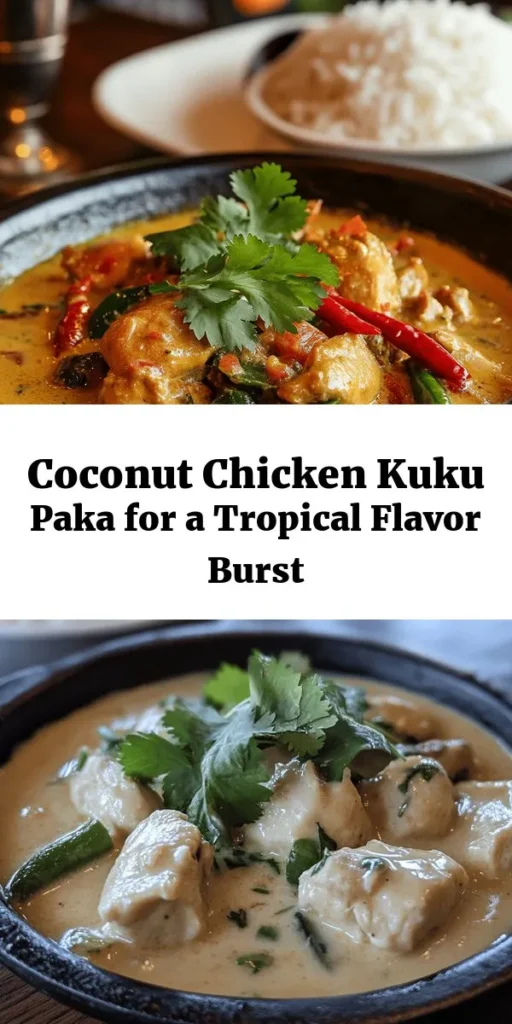Introduction
Kuku Paka is a tantalizing dish that embodies the rich culinary traditions of East Africa, specifically highlighting the influence of Swahili cuisine. This flavorful chicken curry, infused with the creamy goodness of coconut milk and a medley of spices, has gained popularity not only for its taste but also for its cultural significance. The harmonious blend of spices, combined with the comforting sweetness of coconut milk, makes Kuku Paka a cherished dish on dinner tables across many communities. Whether you are hosting a festive gathering or enjoying a cozy family meal, Kuku Paka is versatile enough to suit any occasion, bringing warmth and joy with every bite.
The unique combination of ingredients in Kuku Paka sets it apart from other chicken dishes. Fresh, high-quality chicken forms the basis of this recipe, while the use of coconut milk adds a rich creaminess that complements the spices beautifully. The aromatic profile is enhanced by garlic, ginger, and onions, creating a foundation that is both fragrant and flavorful. Green chilies introduce a touch of heat, which can be adjusted according to personal preference, allowing this dish to cater to varying tastes. All these elements come together to create a delightful culinary experience that is sure to impress.
Understanding Kuku Paka
The origins of Kuku Paka can be traced back to the coastal regions of East Africa, where Indian, Arab, and African influences converge to form a unique culinary landscape. The Swahili people, primarily settled along the coast of Kenya and Tanzania, have developed a diverse cuisine that reflects their rich history of trade and cultural exchange. Kuku Paka is a perfect representation of this fusion, showcasing the use of coconut milk—a staple in coastal cooking—alongside spices that are reminiscent of Indian curry.
Cultural importance is deeply embedded in this dish, as it often graces tables during special occasions, family gatherings, and festivals. The preparation of Kuku Paka is a communal affair, with family members often coming together to share in the cooking process, making it not only a meal but also an experience that strengthens bonds. This dish is not just about sustenance; it is a celebration of heritage and community, enjoyed by many across different backgrounds.
Kuku Paka’s popularity can be seen across various communities, transcending borders and bringing people together. In homes, it is a go-to recipe for family dinners, while in festive settings, it is often served alongside rice or flatbreads, allowing for a satisfying meal that can feed many. This adaptability ensures that Kuku Paka remains a beloved dish, capable of fitting into any culinary scenario, from casual weeknight dinners to elaborate celebrations.
Ingredients Breakdown
Whole Chicken
The foundation of Kuku Paka is undoubtedly the chicken, which should ideally be fresh and of high quality. Using a whole chicken allows for a more flavorful dish, as the bones and skin contribute to a richer sauce. When selecting your chicken, look for free-range or organic options, as these tend to have a better texture and taste. The chicken is typically cut into pieces, making it easier to marinate and cook evenly, ensuring that each bite is juicy and tender.
Coconut Milk
Coconut milk is the star ingredient in Kuku Paka, giving the dish its signature creaminess and subtle sweetness. It acts as a luxurious base for the curry, balancing the spices and enriching the overall flavor profile. When choosing coconut milk, opt for full-fat versions to achieve the best consistency and taste. The creamy texture of coconut milk not only enhances the dish’s flavors but also provides a comforting element, making every spoonful a delight.
Onions, Garlic, and Ginger
These three ingredients form the aromatic backbone of Kuku Paka. Onions add sweetness and depth, while garlic and ginger introduce warmth and a hint of spice. Together, they create a fragrant base that infuses the chicken with flavor. When preparing the dish, it is essential to sauté these ingredients until they are soft and golden, allowing their natural sugars to caramelize and develop a rich flavor that permeates the entire dish.
Green Chilies
Green chilies are a key component in Kuku Paka, providing the necessary heat to elevate the dish. The level of spice can be adjusted based on personal preference; for a milder version, use fewer chilies or remove the seeds. Conversely, for those who enjoy a kick, feel free to add more. The vibrant color and flavor of green chilies not only enhance the dish’s appearance but also contribute to its overall taste, making it a perfect balance of spice and creaminess.
Curry Powder and Turmeric
Curry powder and turmeric are essential spices that play a significant role in flavor development. Curry powder, a blend of various spices, adds complexity and warmth, while turmeric provides a beautiful golden hue and is known for its health benefits, including anti-inflammatory properties. The combination of these spices gives Kuku Paka its distinctive taste, making it a comforting yet exciting dish to savor.
Tomato Paste
Tomato paste is used in Kuku Paka to add depth and acidity to the sauce. It balances the richness of the coconut milk and helps to enhance the overall flavor profile of the dish. By incorporating tomato paste, the sauce develops a vibrant color and a slightly tangy taste, which complements the sweetness of the coconut milk and the warmth of the spices.
Fresh Cilantro
Finally, fresh cilantro is used as a garnish, adding a burst of color and a fresh, herbal note to the finished dish. Its bright flavor helps to lighten the overall richness of Kuku Paka, making it a perfect finishing touch. Additionally, cilantro is often associated with various health benefits, including antioxidant properties, making it a wholesome addition to this already nutritious dish.
Preparation Steps
Marinating the Chicken
Marinating is a crucial step in preparing Kuku Paka, as it allows the chicken to absorb the flavors of the spices and aromatics. For optimal results, marinate the chicken for at least two hours, although longer marination (up to overnight) will yield even more intense flavors. The marinade typically consists of a mixture of curry powder, turmeric, garlic, ginger, and a bit of salt, which, when combined with the natural juices of the chicken, creates a flavorful base that infuses each piece of meat.
To effectively marinate the chicken, first, create the marinade by mixing the spices with a bit of coconut milk to form a paste. Rub this mixture all over the chicken pieces, ensuring that every surface is coated. Place the marinated chicken in a bowl or resealable bag, cover it, and refrigerate. This not only enhances the flavor but also tenderizes the meat, resulting in a juicy and succulent dish.
Sautéing the Aromatics
Once the chicken has marinated, it’s time to sauté the aromatics. Heat a large pot or deep skillet over medium heat and add a splash of oil. Begin by adding the chopped onions, stirring them gently until they become translucent and start to caramelize. This process is essential, as it builds the flavor base for the dish. Next, add minced garlic and ginger, cooking until fragrant—this typically takes about one minute.
The key to successful sautéing lies in controlling the heat and allowing the flavors to develop without burning the aromatics. By taking your time during this step, you create a delicious foundation for the rest of the dish, ensuring that each bite of Kuku Paka is bursting with flavor. Once the aromatics are well-cooked, you’re ready to proceed with the next steps in crafting this delightful coconut chicken curry.
In the following sections, we will explore the remaining steps involved in completing the Kuku Paka recipe, ensuring that you have all the necessary information to recreate this beloved dish in your own kitchen. Stay tuned for the continuation of this culinary journey, where we will guide you through the finishing touches that make Kuku Paka a truly unforgettable experience.

Tips for Achieving the Perfect Caramelization of Onions
Caramelizing onions is a crucial step in the Kuku Paka recipe, as it lays the foundation for the entire dish’s flavor. To achieve perfectly caramelized onions, start with a good quality, heavy-bottomed skillet. This will provide even heat distribution, which is essential for uniform cooking.
1. Temperature Control: Begin by heating your skillet over medium heat. Once hot, add a generous amount of oil or ghee. The key is to start at medium heat and adjust as necessary. If the heat is too high, the onions will burn instead of caramelizing.
2. Patience is Key: Add the onions and a pinch of salt to the skillet. Stir them occasionally to ensure they cook evenly. Allow the onions to cook slowly for about 20 to 30 minutes, stirring every 5-10 minutes. This slow cooking process allows the natural sugars in the onions to caramelize beautifully, turning them golden brown and enhancing their sweetness.
3. Deglazing: If you notice that the onions are starting to stick to the pan, you can add a splash of water or broth. This will not only help with deglazing but will also add depth to the flavor.
Adding Garlic, Ginger, and Spices
Once your onions have reached that perfect caramelized state, it’s time to add garlic, ginger, and spices. Timing is crucial here, as you want to ensure these aromatic ingredients retain their flavor without becoming bitter.
– Incorporation Timing: Add minced garlic and ginger to the caramelized onions and stir for about 30 seconds to a minute. This allows their essential oils to release without burning.
– Aromatic Spices: After the garlic and ginger become fragrant, it’s time to introduce your spices, such as cumin, coriander, and turmeric. These spices should be added for just a minute, allowing them to bloom and infuse the oil with their rich aromas. The result is a beautifully aromatic base, with layers of flavor that will permeate the chicken.
Cooking the Chicken
Now that your aromatic base is ready, it’s time to brown the chicken. This step is essential for developing depth of flavor through the Maillard reaction, which occurs when proteins in the chicken react with heat, creating complex flavors and a rich color.
1. Browning Technique: Add the chicken pieces into the skillet in a single layer. Avoid overcrowding the pan, as this will lead to steaming rather than browning. Let the chicken cook undisturbed for about 4-5 minutes on each side until golden brown.
2. Absorbing Flavors: As you turn the chicken, it will begin to absorb the flavors from the onions, garlic, ginger, and spices. This step is crucial, as it enhances the overall taste profile of your Kuku Paka.
The Maillard Reaction
Understanding the Maillard reaction can greatly enhance your cooking. This chemical reaction between amino acids and reducing sugars gives browned foods their distinctive flavor. In the case of Kuku Paka, achieving that perfect golden-brown crust on the chicken not only adds flavor but also enhances the visual appeal of the dish.
Incorporating Coconut Milk
Once your chicken is beautifully browned, it’s time to incorporate the star ingredient: coconut milk. This rich, creamy addition is what makes Kuku Paka a delightfully comforting dish.
1. Consistency: Pour in the coconut milk and stir well to combine. The amount of coconut milk you add can be adjusted based on your desired sauce consistency. For a thicker sauce, use less coconut milk; for a creamier texture, add more.
2. Balancing Creaminess and Thickness: The balance between creaminess and thickness is important. You want a sauce that clings to the chicken but is still pourable. If it becomes too thick, you can adjust with a little chicken broth or water.
Simmering
Simmering is where the magic happens. After incorporating the coconut milk, bring the mixture to a gentle simmer.
1. Cooking Time and Temperature: Lower the heat to maintain a gentle simmer and cover the skillet. This method allows the chicken to cook through while the flavors meld together. A cooking time of 20-30 minutes should suffice, depending on the size of your chicken pieces.
2. Checking Doneness: To check for doneness, insert a meat thermometer into the thickest part of the chicken; it should read 165°F (75°C). Alternatively, cut into a piece of chicken to ensure that the juices run clear and the meat is no longer pink.
Finalizing and Serving
Once your chicken is cooked through, it’s time to finalize the dish. Taste the sauce and adjust the seasoning as needed. Adding a touch of salt or a squeeze of lime juice can elevate the flavors even more.
Presentation Tips: Serve your Kuku Paka in a large, beautiful serving dish that showcases the vibrant colors of the chicken and the creamy coconut sauce. Garnish with freshly chopped cilantro or spring onions for a pop of color. Pair it with a sprinkle of lime zest for added freshness.
Serving Suggestions
Kuku Paka is a versatile dish that can be served with various accompaniments to enhance the dining experience.
1. Steamed Rice: Jasmine or Basmati rice are excellent choices for pairing with Kuku Paka. Jasmine rice has a slight floral aroma and a sticky texture, while Basmati rice offers a nuttier flavor and fluffy texture. Both absorb the coconut sauce beautifully.
2. Flatbreads: Consider serving the dish with chapati or naan to scoop up the luscious sauce. These flatbreads complement the rich flavors of Kuku Paka and provide a delightful textural contrast.
3. Communal Dining: Kuku Paka is perfect for communal meals. Serve it in the center of the table with rice and flatbreads surrounding it, allowing everyone to help themselves. This shared dining experience fosters connection and joy among family and friends.
Nutritional Information
Kuku Paka is not only delicious but also nutritious. The chicken provides a good source of protein, while the coconut milk contributes healthy fats that can support heart health. The spices used in this dish, such as turmeric and ginger, are known for their anti-inflammatory properties, making Kuku Paka a wholesome option.
Conclusion
Kuku Paka is truly a delightful dish that marries the rich flavors of coconut milk with the savory notes of chicken and spices. By following the steps outlined, you can create a meal that is not only satisfying but also carries a sense of cultural heritage and communal spirit.
We encourage you to try making Kuku Paka at home. Experience its rich flavors and the joy of sharing this dish with loved ones. Whether served on a quiet weeknight or at a festive gathering, Kuku Paka promises to bring warmth and happiness to your table. Enjoy the process of cooking, and relish the rewards of a beautifully crafted meal that brings people together.



